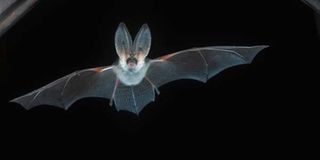How bats use a compass to find their way at night

Bats too can transmit rabies. PHOTO | NATIONAL GEOGRAPHIC
What you need to know:
- They leave their roosts in caves, trees and buildings at night to hunt for insects, often ranging hundreds of kilometres and returning before sunrise to avoid predators.
- Scientists have long wondered whether bats could read the pattern of sunlight scattered in the atmosphere (polarisation) to orientate themselves to Earth's magnetic field. These patterns depend on where the Sun is in the sky, and are used by insects, birds, fish, amphibians and reptiles in navigation.
- Trying to make their way home, the two groups flew in different directions, with more of those exposed to the natural patterns approaching the target.
PARIS,
A European bat type can use the scatter patterns of sunlight to programme its internal compass for hunting after dark -- the first mammal known to do so, researchers said Tuesday.
The only flying mammals, bats use echolocation, a form of sonar, to find their way around, but this only works at distances up to about 50 metres (164 feet).
They leave their roosts in caves, trees and buildings at night to hunt for insects, often ranging hundreds of kilometres and returning before sunrise to avoid predators.
"We knew they had to be using another of their senses for longer-range navigation," said Stefan Greif of Queen's University Belfast, co-author of a study published in the journal Nature Communications.
Scientists have long wondered whether bats could read the pattern of sunlight scattered in the atmosphere (polarisation) to orientate themselves to Earth's magnetic field.
These patterns depend on where the Sun is in the sky, and are used by insects, birds, fish, amphibians and reptiles in navigation.
CLEAR VIEW
For the study, a team of biologists captured 70 female greater mouse-eared bats in Bulgaria and placed them in see-through cages at a site 1.3 kilometres (0.8 miles) from their cave.
The windows were covered with light polarising filters -- some of them oriented so the bats were exposed to "natural" scatter patterns and others tilted at a 90-degree angle.
The bats were offered a clear view of the horizon and the Sun around dusk, when the scatter pattern is strongest, and then taken to two sites over 20 kilometres away from where they were released on different nights, fitted with radio-transmitters.
Trying to make their way home, the two groups flew in different directions, with more of those exposed to the natural patterns approaching the target.
"The sunset could have been used as a cue to incorporate this information, but apparently bats ignored this and weighed the polarisation cue higher," the study authors concluded.
It is not known, however, how the bats manage this feat. Other animals which use polarisation patterns have special eye adaptations.
Animals rely on a range of sensory information for navigation -- the position of the Sun or stars, the Earth's magnetic field, smells, visual cues, or light scatter patterns.
These inputs have to be calibrated against one another for the most accurate result.
Bats, which are natural pest controllers, are in decline across Europe.
"Anything we can do to understand how they get about, how they move and navigate will be a step forward in helping to protect them," fellow researcher Richard Holland said in a statement.





